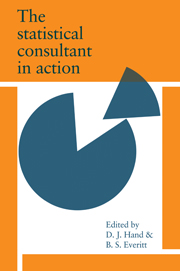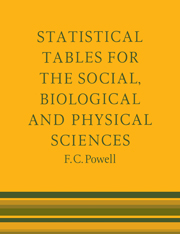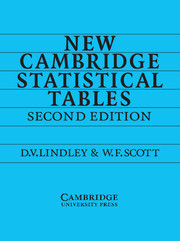Statistical Case Studies Instructor Edition
Statisticians know that the clean data sets that appear in textbook problems have little to do with real-life industry data. To better prepare their students for all types of statistical careers, academic statisticians now strive to use data sets from real-life statistical problems. This book contains 20 case studies that use actual data sets that have not been simplified for classroom use. Each case study is a collaboration between statisticians from academe and from business, industry, or government. This book is the result of a collaborative workshop of statisticians focusing on academic-industrial partnerships. The cases come from a wide variety of application areas, including biology/environment, medical and health care, pharmaceutical, marketing and survey research, and manufacturing.
Product details
January 1998Paperback
9780898714135
184 pages
250 × 180 × 20 mm
0.622kg
This item is not supplied by Cambridge University Press in your region. Please contact Soc for Industrial & Applied Mathematics for availability.
Table of Contents
- Preface
- Introductions: The Benefits of Cases, Partnering for the Future of the Statistics Profession
- Chapter 1: Are the Fish Safe to Eat? Assessing Mercury Levels in Fish in Maine Lakes
- Chapter 2: Chemical Assay Validation
- Chapter 3: Automating a Manual Telephone Process
- Chapter 4: Dissolution Method Equivalence
- Chapter 5: Comparison of Hospital Length of Stay Between Two Insurers for Patients with Pediatric Asthma
- Chapter 6: Comparing Nonsteroidal Anti-inflammatory Drugs with Respect to Stomach Damage
- Chapter 7: Validating an Assay of Viral Contamination
- Chapter 8: Control Charts for Quality Characteristics Under Nonnormal Distributions
- Chapter 9: Evaluation of Sound to Improve Customer Value
- Chapter 10: Improving Integrated Circuit Manufacture Using a Designed Experiment
- Chapter 11: Evaluating the Effects of Nonresponse and the Number of Response Levels on Survey Samples
- Chapter 12: Designing an Experiment to Obtain a Target Value in the Chemical Processes Industry
- Chapter 13: Investigating Flight Response of Pacific Brant to Helicopters at Izembek Lagoon, Alaska by Using Logistic Regression
- Chapter 14: Estimating the Biomass of Forage Fishes in Alaska's Prince William Sound Following the Exxon Valdez Oil Spill
- Chapter 15: A Simplified Simulation of the Impact of Environmental Interference on Measurement Systems in an Electrical Components Testing Laboratory
- Chapter 16: Cerebral Blood Flow Cycling: Anesthesia and Arterial Blood Pressure
- Chapter 17: Modeling Circuit Board Yields
- Chapter 18: Experimental Design for Process Settings in Aircraft Manufacturing
- Chapter 19: An Evaluation of Process Capability for Fuel Injector Process Using Monte Carlo Simulation
- Chapter 20: Data Fusion and Maintenance Policies for Continuous Production Processes
- Index.






